Optical Properties of Plasma Dimer Nanoparticles for Solar Energy Absorption
Abstract
:1. Introduction
2. Modeling
3. Results and Discussions
3.1. Absorption and Scattering Efficiencies and Resonance Mode of Plasma Dimer
3.2. Effects of Geometric Parameters and Embedding during Synthesis
3.3. Trimers and Their Special Structures
4. Conclusions
Author Contributions
Funding
Institutional Review Board Statement
Informed Consent Statement
Data Availability Statement
Conflicts of Interest
References
- Huang, M.T.; Zhai, P.M. Achieving Paris Agreement temperature goals requires carbon neutrality by middle century with far-reaching transitions in the whole society. Adv. Clim. Chang. Res. 2021, 12, 281–286. [Google Scholar] [CrossRef]
- Taner, G. Renewable energy, non-renewable energy and sustainable development. Int. J. Sustain. Dev. World Ecol. 2019, 26, 389–397. [Google Scholar]
- Devabhaktuni, V.; Alam, M.; Depuru, S.S.S.R.; GrCambridge, M.A.; USAeen, R.C.; Nims, D.; Near, C. Solar energy: Trends and enabling technologies. Renew. Sustain. Energy Rev. 2013, 19, 555–564. [Google Scholar] [CrossRef]
- Zhang, T.; Wang, S.J.; Zhang, X.Y.; Fu, M.; Yang, Y.; Chen, W.; Su, D. Recent progress on nanostructure-based broadband absorbers and their solar energy thermal utilization. Front. Chem. Sci. Eng. 2020, 15, 35–48. [Google Scholar] [CrossRef]
- Meng, Z.G.; Li, Y.; Chen, N.; Wu, D.X.; Zhu, H.T. Broad-band absorption and photo-thermal conversion properties of zirconium carbide aqueous nanofluids. J. Taiwan Inst. Chem. Eng. 2017, 80, 286–292. [Google Scholar] [CrossRef]
- Hayat, M.B.; Ali, D.; Monyake, K.C.; Alagha, L.; Ahmed, N. Solar energy—A look into power generation, challenges, and a solar-powered future. Int. J. Energy Res. 2019, 43, 1049–1067. [Google Scholar] [CrossRef]
- He, Y.L.; Wang, K.; Qiu, Y.; Du, B.C.; Liang, Q.; Du, S. Review of the solar flux distribution in concentrated solar power: Non-uniform features, challenges, and solutions. Appl. Therm. Eng. 2018, 149, 448–474. [Google Scholar] [CrossRef]
- Wang, Z.Y.; Huang, H.; Li, G.; Yan, X.H.; Yu, Z.C.; Wang, K.Y.; Wu, Y.C. Advances in engineering perovskite oxides for photochemical and photoelectrochemical water splitting. Appl. Phys. Rev. 2021, 8, 021320. [Google Scholar] [CrossRef]
- Morschett, H.; Loomba, V.; Huber, G.; Wiechert, W.; Lieres, E.V.; Oldiges, M. Laboratory scale photobiotechnology—Current trends and future perspectives. FEMS Microbiol. Lett. 2018, 365, fnx238. [Google Scholar] [CrossRef]
- Qiu, Y.; Xu, Y.C.; Li, Q.; Wang, J.K.; Wang, Q.L.; Liu, B. Efficiency enhancement of a solar trough collector by combining solar and hot mirrors. Appl. Energy 2021, 299, 117290. [Google Scholar] [CrossRef]
- Wole-osho, I.; Okonkwo, E.C.; Abbasoglu, S.; Kavaz, D. Nanofluids in Solar Thermal Collectors: Review and Limitations. Int. J. Thermophys. 2020, 41, 157. [Google Scholar] [CrossRef]
- Wang, K.Y.; Tian, T.; Shi, Y.C. Release of top 10 scientific issues for 2020 concerning human society development and global science technology cooperation. Sci. Technol. Rev. 2021, 39, 9–16. [Google Scholar]
- Tyagi, H.; Phelan, P.; Prasher, R. Predicted Efficiency of a Low-Temperature Nanofluid-Based Direct Absorption Solar Collector. J. Sol. Energy Eng. 2009, 131, 041004. [Google Scholar] [CrossRef]
- He, Y.R.; Chen, M.J.; Wang, X.Z.; Hu, Y.W. Plasmonic multi-thorny Gold nanostructures for enhanced solar thermal conversion. Sol. Energy 2018, 171, 73–82. [Google Scholar] [CrossRef]
- Siavashi, M.; Bozorg, M.V.; Toosi, M.H. A numerical analysis of the effects of nanofluid and porous media utilization on the performance of parabolic trough solar collectors. Sustain. Energy Technol. Assess. 2021, 45, 101179. [Google Scholar]
- Mahian, O.; Bellos, E.; Markides, C.N.; Taylor, R.A.; Alagumalai, A.; Yang, L.; Qin, C.Y.; Lee, B.J.; Ahmadi, G.; Safaei, M.R.; et al. Recent Advances in Using Nanofluids in Renewable Energy Systems and the Environmental Implications of their Uptake. Nano Energy 2021, 86, 106069. [Google Scholar] [CrossRef]
- Meng, Z.G.; Han, D.X.; Wu, D.X.; Zhu, H.T.; Li, Q.L. Thermal Conductivities, Rheological Behaviors and Photothermal Properties of Ethylene Glycol-based Nanofluids Containing Carbon Black Nanoparticles. Procedia Eng. 2012, 36, 521–527. [Google Scholar] [CrossRef] [Green Version]
- Chen, W.J.; Zou, C.J.; Li, X.K.; Liang, H. Application of recoverable carbon nanotube nanofluids in solar desalination system: An experimental investigation. Desalination 2017, 451, 92–101. [Google Scholar] [CrossRef]
- Omisanya, M.I.; Kanmi, H.; Adedayo, S.A.; Adediran, I.A.; Asafa, T. Enhancing the thermal performance of solar collectors using nanofluids. IOP Conf. Ser. Mater. Sci. Eng. 2020, 805, 012015. [Google Scholar] [CrossRef]
- Chen, M.J.; He, Y.R.; Zhu, J.Q.; Wen, D.S. Investigating the collector efficiency of silver nanofluids based direct absorption solar collectors. Appl. Energy 2016, 181, 65–74. [Google Scholar] [CrossRef]
- Choi, S. Enhancing thermal conductivity of fluids with nanoparticles. Fluids Eng. Div. 1995, 231, 99–105. [Google Scholar]
- Lee, B.J.; Park, K.; Walsh, T.; Xu, L. Radiative Heat Transfer Analysis in Plasmonic Nanofluids for Direct Solar Thermal Absorption. J. Sol. Energy Eng. 2012, 134, 021009. [Google Scholar] [CrossRef] [Green Version]
- Taylor, R.A.; Phelan, P.E.; Otanicar, T.P.; Adrian, R.; Prasher, R. Nanofluid optical property characterization: Towards efficient direct absorption solar collectors. Nanoscale Res. Lett. 2011, 6, 225. [Google Scholar] [CrossRef] [PubMed] [Green Version]
- Otanicar, T.; Phelan, P.E.; Prasher, R.S.; Rosengarten, G.; Taylor, R.A. Nanofluid-based direct absorption solar collector. J. Renew. Sustain. Energy 2010, 2, 033102. [Google Scholar] [CrossRef] [Green Version]
- Qin, C.Y.; Kim, J.B.; Lee, B.J. Performance analysis of a direct-absorption parabolic-trough solar collector using plasmonic nanofluids. Renew. Energy 2019, 143, 24–33. [Google Scholar] [CrossRef] [Green Version]
- Qin, C.Y.; Kang, K.; Lee, I.; Lee, B.J. Optimization of a direct absorption solar collector with blended plasmonic nanofluids. Sol. Energy 2017, 150, 512–520. [Google Scholar] [CrossRef]
- Wang, D.B.; Liang, W.W.; Zheng, Z.H.; Jia, P.Y.; Yan, Y.R.; Xie, H.Q.; Wang, L.L.; Yu, W. Highly efficient energy harvest via external rotating magnetic field for oil based nanofluid direct absorption solar collector. Green Energy Environ. 2020, 6, 298–307. [Google Scholar] [CrossRef]
- Chen, W.J.; Zou, C.J.; Li, X.K. An investigation into the thermophysical and optical properties of SiC/ionic liquid nanofluid for direct absorption solar collector. Sol. Energy Mater. Sol. Cells 2017, 163, 157–163. [Google Scholar] [CrossRef]
- Ghodselahi, T.; Neishaboorynejad, T.; Arsalani, S. Fabrication LSPR sensor chip of Ag NPs and their biosensor application based on inter-particle coupling. Appl. Surf. Sci. 2015, 343, 194–201. [Google Scholar] [CrossRef]
- Xuan, Y.M.; Duan, H.L.; Li, Q. Enhancement of solar energy absorption using a plasmonic nanofluid based on TiO2/Ag composite nanoparticles. RSC Adv. 2014, 4, 16206–16213. [Google Scholar] [CrossRef]
- Mahian, O.; Kolsi, L.; Amain, M.; Estelle, P.; Ahmadi, G.; Kleinstreuer, C.; Marshall, J.S.; Taylo, R.A.; Nada, E.A.; Rashidi, S.; et al. Recent advances in modeling and simulation of nanofluid flows—Part II: Applications. Phys. Rep. 2019, 791, 1–59. [Google Scholar] [CrossRef]
- Chen, M.J.; He, Y.R.; Huang, J.; Zhu, J.Q. Investigation into Au nanofluids for solar photothermal conversion. Int. J. Heat Mass Transf. 2017, 108, 1894–1900. [Google Scholar] [CrossRef]
- Wang, Z.L.; Quan, X.J.; Zhang, Z.M.; Cheng, P. Optical Absorption of Carbon-Gold Core-Shell Nanoparticles. J. Quant. Spectrosc. Radiat. Transf. 2018, 205, 291–298. [Google Scholar] [CrossRef]
- Qin, C.Y.; Kim, J.B.; Gonome, H.; Lee, B.J. Absorption characteristics of nanoparticles with sharp edges for a direct-absorption solar collector. Renew. Energy 2020, 145, 21–28. [Google Scholar] [CrossRef]
- Chen, Z.; Chen, M.J.; Yan, H.J.; Zhou, P.; Chen, X.Y. Enhanced solar thermal conversion performance of plasmonic gold dimer nanofluids. Appl. Therm. Eng. 2020, 178, 115561. [Google Scholar] [CrossRef]
- Myroshnychenko, V.; Rodrı’guez-Fernández, J.; Pastoriza-Santos, I.; Funston, A.M.; Novo, C.; Mulvaney, P.; Liz-Marzán, L.M.; Abajo, F.J.G. Modelling the optical response of gold nanoparticles. Chem. Soc. Rev. 2008, 37, 1792–1805. [Google Scholar] [CrossRef] [Green Version]
- Qin, C.Y.; Guo, Y.M.; Seo, J.Y.; Shuai, Y.; Lee, J.; Lee, B.J. Absorption Characteristics of a Metal-Insulator-Metal Nanodisk for Solar Thermal Applications. Optics Express 2020, 28, 15731–15743. [Google Scholar] [CrossRef]
- Cai, W.; Shalaev, V.M. Experimental Techniques and Data Treatment. In Optical Metamaterials; Springer: New York, NY, USA, 2010. [Google Scholar]
- Chen, X.Y.; Zhou, P.; Yan, H.J.; Chen, M.J. Systematically investigating solar absorption performance of plasmonic nanoparticles. Energy 2020, 216, 119254. [Google Scholar] [CrossRef]
- Kumar, G.V.P. Plasmonic nano-architectures for surface enhanced Raman scattering: A review. J. Nanophotonics 2012, 6, 064503. [Google Scholar] [CrossRef] [Green Version]
- Hentschel, M.; Saliba, M.; Vogelgesang, R.; Giessen, H.; Alivisatos, A.P.; Liu, N. Transition from Isolated to Collective Modes in Plasmonic Oligomers. Nano Lett. 2010, 10, 2721–2726. [Google Scholar] [CrossRef]
- Palik, E. Handbook of Optical Constants of Solids; Academic Press: Cambridge, MA, USA, 1998. [Google Scholar]
- Chehaidar, A.; Hadded, M. Scattering and absorption of light by homogeneous BiFeO3 and hybrid BiFeO3/Au core/shell spherical nanoparticles: A computational study. Opt. Mater. 2019, 95, 109207. [Google Scholar] [CrossRef]
- Wang, X.J.; Cao, Y. Characterizations of Absorption, Scattering, and Transmission of Typical Nanoparticles and Their Suspensions. J. Ind. Eng. Chem. 2019, 82, 324–332. [Google Scholar] [CrossRef]
- Loudon, R. The propagation of electromagnetic energy through an absorbing di-electric. J. Phys. A Gen. Phys. 1970, 3, 233–245. [Google Scholar] [CrossRef]
- Tang, H.; Li, X.X. Research on the single scattering albedo of spheroids. Int. J. Numer. Methods Heat Fluid Flow 2014, 24, 1762–1768. [Google Scholar] [CrossRef]
- Won, K.H.; Lee, B.J. Effect of light scattering on the performance of a direct absorption solar collector. Front. Energy 2018, 12, 169–177. [Google Scholar] [CrossRef]
- Kumar, P.S.; Pastoriza-Santos, I.; Rodr´ıguez-González, B.; Abajo, F.J.G.; Liz-Marzán, L.M. High-yield synthesis and optical response of gold nanostars. Nanotechnology 2008, 19, 015606. [Google Scholar] [CrossRef] [PubMed]
- Cui, L.; Huang, M.Y.; You, Y.M.; Zhang, Y.J.; Li, G.M.; Liu, S.L.; Liu, C.K. Electric and magnetic resonances in optical metamaterial for efficient absorption enhancement in ultrathin CdTe-based photovoltaic cells. Opt. Mater. Express 2016, 6, 1480–1487. [Google Scholar] [CrossRef]
- Ross, M.B.; Schatz, G.C. Aluminum and Indium Plasmonic Nanoantennas in the Ultraviolet. J. Phys. Chem. C 2014, 118, 12506–12514. [Google Scholar] [CrossRef]
- Chen, W.; Hu, H.T.; Jiang, W.; Xu, Y.H.; Zhang, S.P.; Xu, H.X. Ultrasensitive nanosensors based on localized surface plasmon resonances: From theory to applications. Chin. Phys. B 2018, 27, 107403. [Google Scholar] [CrossRef]
- Shams-nateri, A. Scattering behavior of nonabsorbing metallic nanoparticles. Opt. Laser Technol. 2012, 44, 1670–1674. [Google Scholar] [CrossRef]
- Campione, S.; Adams, S.M.; Ragan, R.; Capolino, F. Comparison of electric field enhancements: Linear and triangular oligomers versus hexagonal arrays of plasmonic nanospheres. Opt. Express 2013, 21, 7957–7973. [Google Scholar] [CrossRef] [PubMed] [Green Version]
- Park, K.J.; Huh, J.H.; Jung, D.W.; Park, J.S.; Choi, G.H.; Lee, G.; Yoo, P.J.; Park, H.G.; Yi, G.R.; Lee, S. Assembly of 3D plasmonic metamolecules by 2D AFM nanomanipulation of highly uniform and smooth gold nanospheres. Sci. Rep. 2017, 7, 1–10. [Google Scholar]
- Lee, R.; Kim, J.B.; Qin, C.Y.; Lee, H.; Lee, B.J.; Jung, G.Y. Synthesis of Therminol-based plasmonic nanofluids with core/shell nanoparticles and characterization of their absorption/scattering coefficients. Sol. Energy Mater. Sol. Cells 2020, 209, 110442. [Google Scholar] [CrossRef]
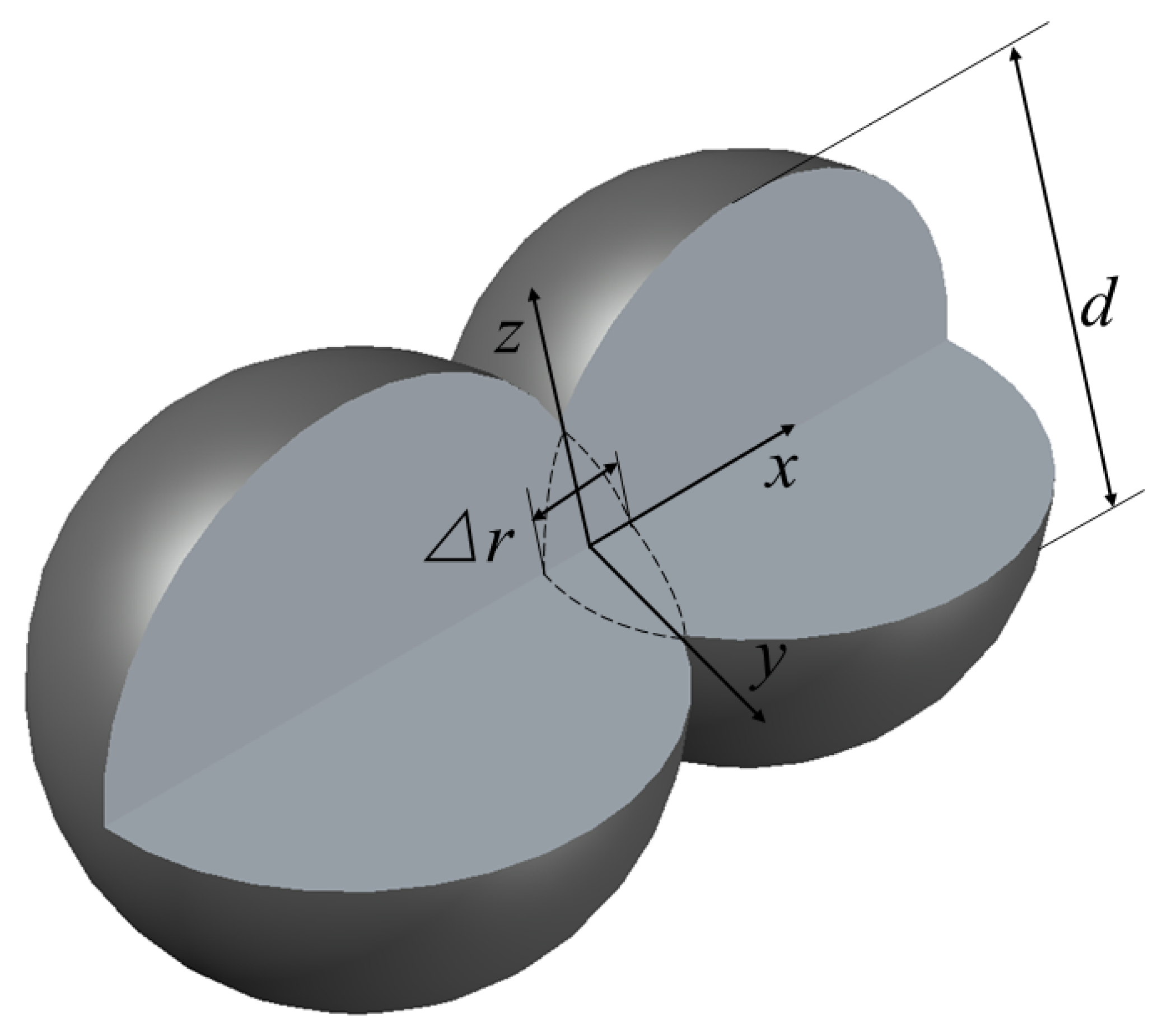


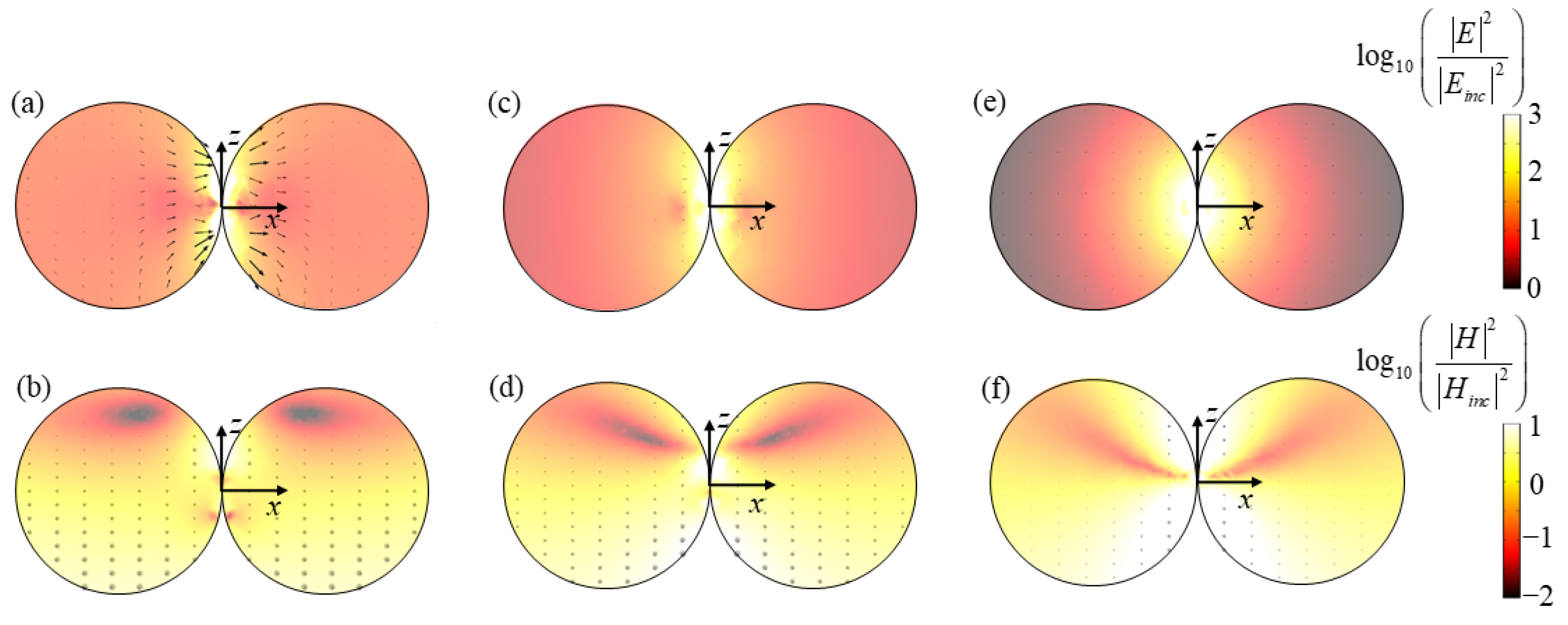

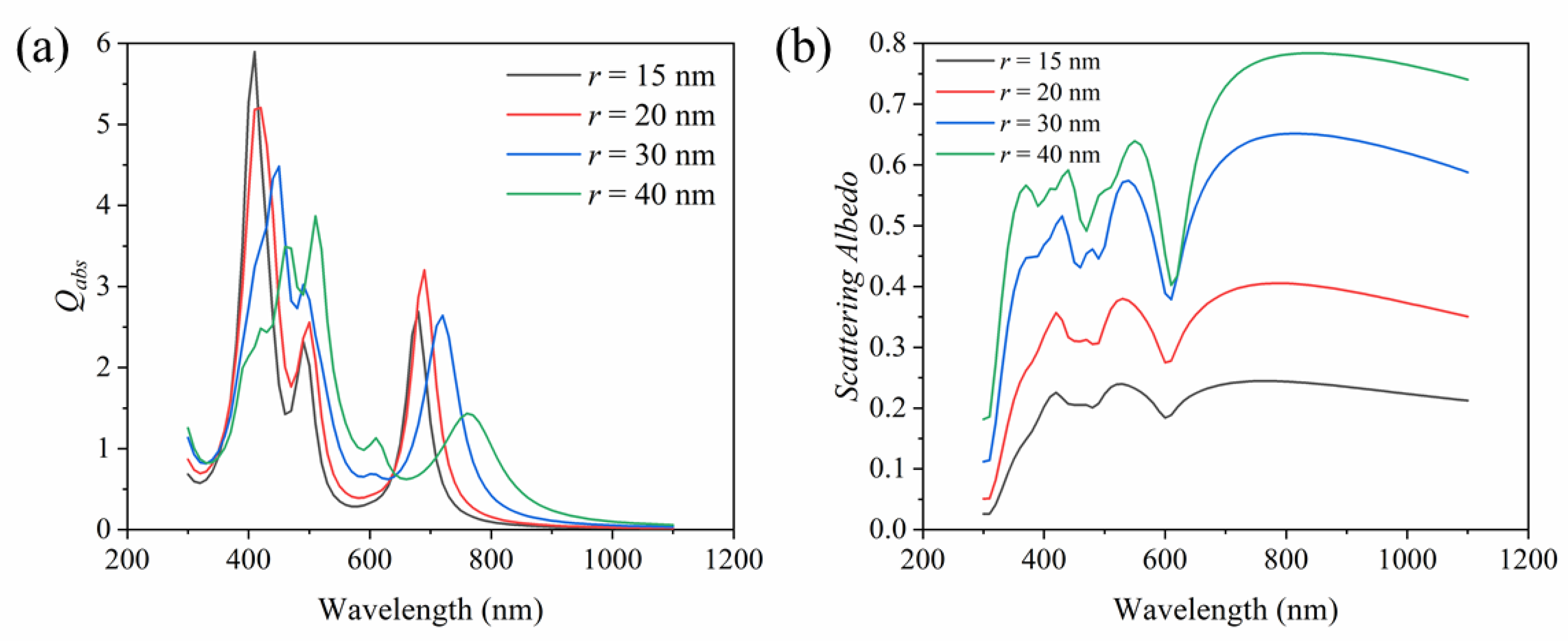

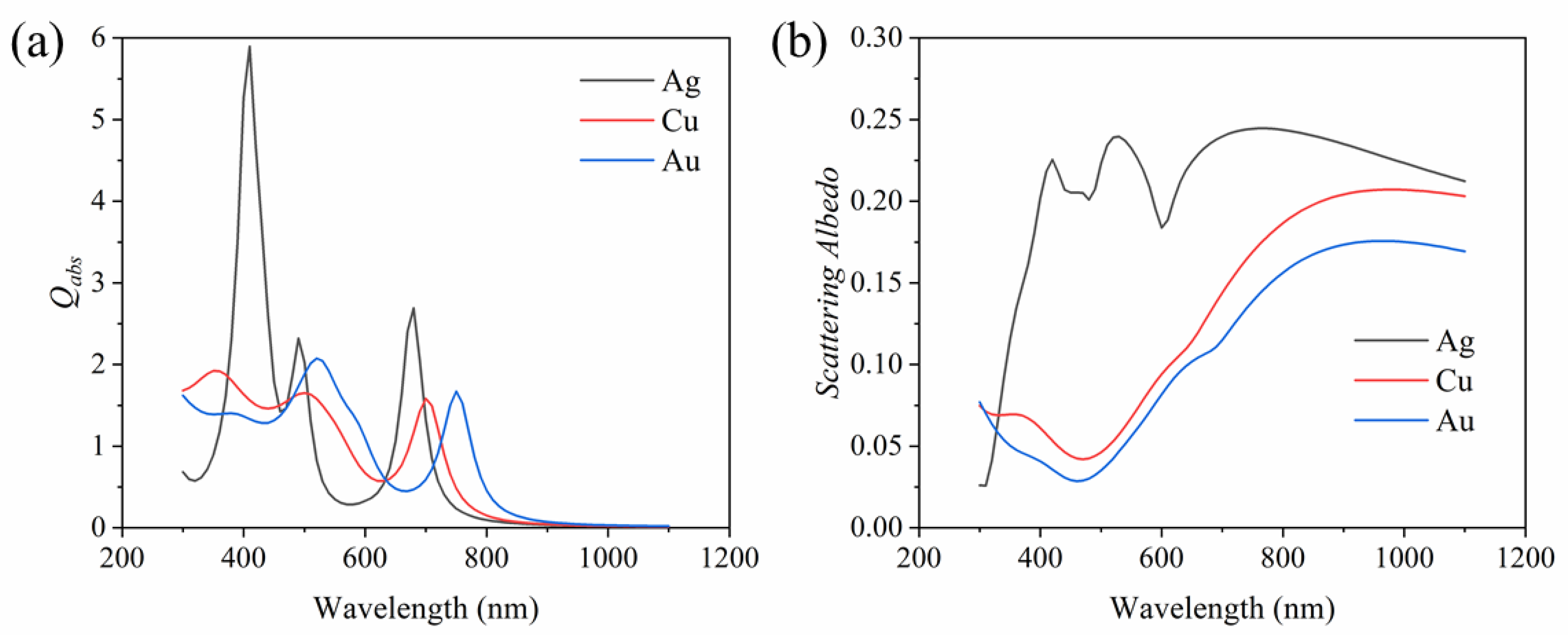

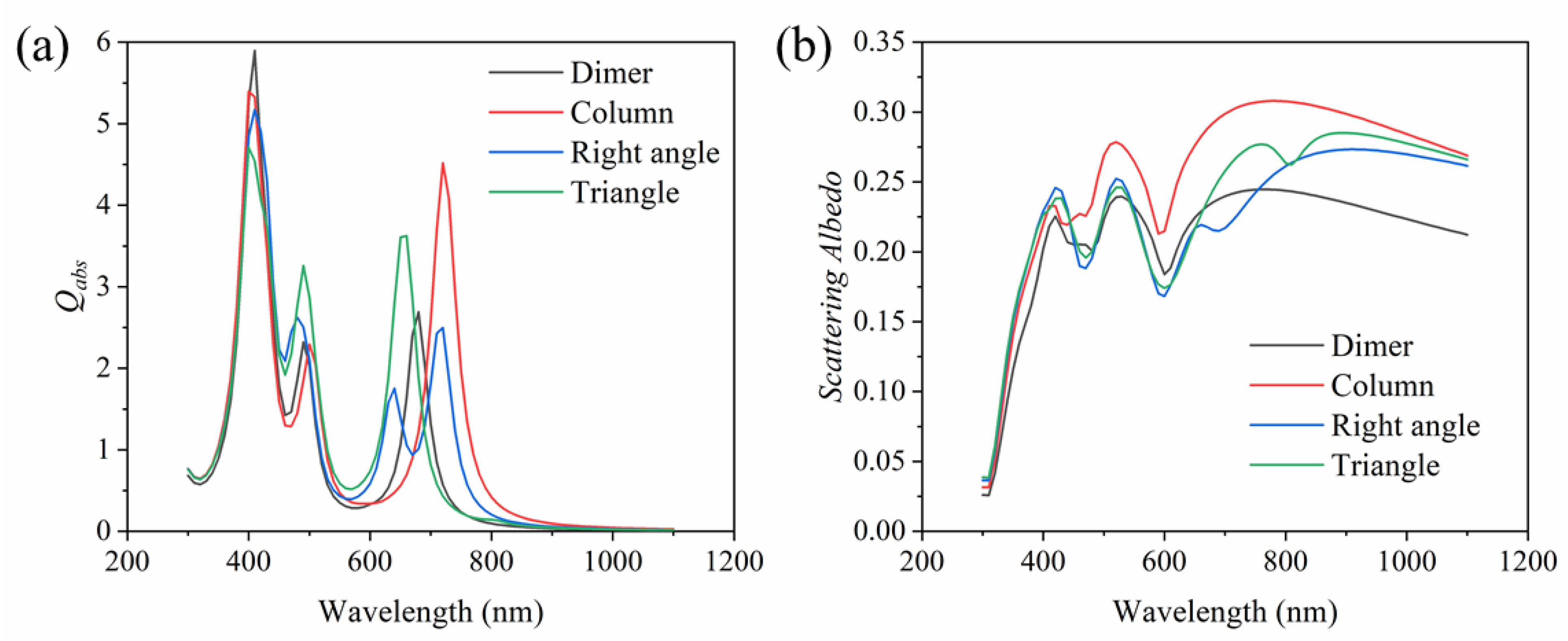


Publisher’s Note: MDPI stays neutral with regard to jurisdictional claims in published maps and institutional affiliations. |
© 2021 by the authors. Licensee MDPI, Basel, Switzerland. This article is an open access article distributed under the terms and conditions of the Creative Commons Attribution (CC BY) license (https://creativecommons.org/licenses/by/4.0/).
Share and Cite
Sun, C.; Qin, C.; Zhai, H.; Zhang, B.; Wu, X. Optical Properties of Plasma Dimer Nanoparticles for Solar Energy Absorption. Nanomaterials 2021, 11, 2722. https://doi.org/10.3390/nano11102722
Sun C, Qin C, Zhai H, Zhang B, Wu X. Optical Properties of Plasma Dimer Nanoparticles for Solar Energy Absorption. Nanomaterials. 2021; 11(10):2722. https://doi.org/10.3390/nano11102722
Chicago/Turabian StyleSun, Chunlei, Caiyan Qin, Han Zhai, Bin Zhang, and Xiaohu Wu. 2021. "Optical Properties of Plasma Dimer Nanoparticles for Solar Energy Absorption" Nanomaterials 11, no. 10: 2722. https://doi.org/10.3390/nano11102722
APA StyleSun, C., Qin, C., Zhai, H., Zhang, B., & Wu, X. (2021). Optical Properties of Plasma Dimer Nanoparticles for Solar Energy Absorption. Nanomaterials, 11(10), 2722. https://doi.org/10.3390/nano11102722






